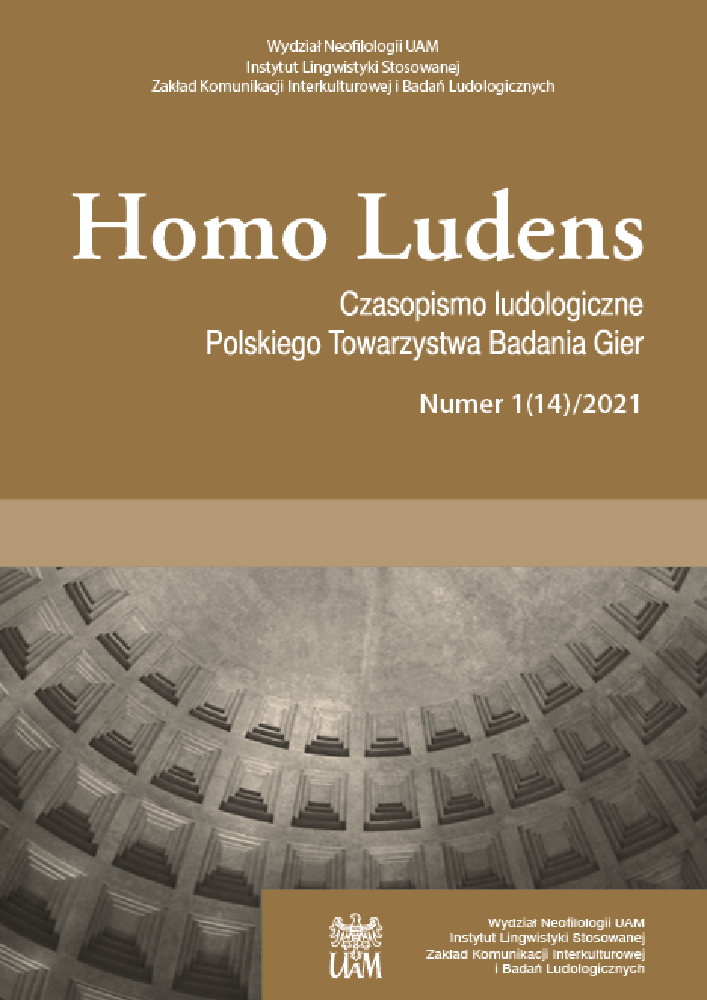Abstrakt
Celem artykułu jest wykazanie, iż pierwowzory gier z gatunku survival horror, którego początek stereotypowo datuje się na lata 90.
XX wieku, można odnaleźć jeszcze w latach 80. Na przykładzie wybranych gier powstałych w owej dekadzie we Francji autor dowodzi, iż już tytuły takie jak Infernal Runner, Le Pacte oraz Zombi ukształtowały poetykę gier survival horror, opartą na ikonografii literatury i filmu grozy, osaczeniu sterowanych awatarów, konfrontacji z obiektami budzącymi efekt grozy oraz symulacji stanów psychicznych postaci.
Bibliografia
Adams, E. (2009). Fundamentals of game design. Berkeley: New Riders.
Anson, J. (2019). Amityville horror (tłum. M. Machała). Czerwonak: Vesper.
Blanchet, A., Montagnon, G. (2020). Une histoire du jeu vidéo en France: 1960–1991: des labos aux chambres d’ados. Houdan: Éditions Pix’n Love.
Caberia, É. (1987). Massacre. Tilt, 46, 134. Online: <https://archive.org/details/Tilt046>.
Caracciolo, M. (2014). The experientiality of narrative: An enactivist approach. Berlin: De Gruyter.
Egenfeldt-Nielsen, S., Smith, J. H., Tosca, S. P. (2015). Understanding video games: The essential introduction. New York – London: Routledge.
Fahs, T. (2012). IGN presents the history of survival horror. Online: <https://uk.ign.com/articles/2009/10/30/ign-presents-the-history-of-survival-horror>.
Godzic, W. (1991). Film i psychoanaliza. Problem widza. Kraków: Wydawnictwo Uniwersytetu Jagiellońskiego.
Habel, C., Kooyman, B. (2014). Agency mechanics: Gameplay design in survival horror video games. Digital Creativity, 25(1), 1–14.
Holmquest, B. (2014). Survival horror, metaculture and the fluidity of video game genres. W: N. Farghaly (red.), Unraveling Resident Evil:
Essays on the complex universe of the games and films (s. 62–79). Jefferson: McFarland & Company.
Jankowski, F. (2015). Przegrana tymczasowa, przegrana permanentna. Ludyczny i egzystencjalny charakter porażki w dwóch wersjach gry
Infernal Runner. Mała Kultura Współczesna, 6(3). Online: <https://bit.ly/2JpIIft>.
Kirkland, E. (2005). Restless dreams in Silent Hill: Approaches to video game analysis. Journal of Media Practice, 6(3), 167–178. Online:<https://www.ingentaconnect.com/content/intellect/tmsd/2005/00000006/00000003/art00005>.
Kjeldgaard-Christiansen, J., & Clasen, M. (2019). Threat simulation in virtual limbo: An evolutionary approach to horror video games. Journal of Gaming & Virtual Worlds, 11(2), 119–138. Online: <https://doi.org/10.1386/jgvw.11.2.119_1>.
Krzywinska, T. (2015). Gaming horror’s horror: Representation, regulation, and affect in survival horror videogames. Journal of Visual Culture, 14(3), 293–297. Online: <https://doi.org/10.1177/1470412915607924>.
Loriciels (1985a). Covers – L’Aigle d’or. CPC Rulez. Online: <https://cpcrulez.fr/GamesTest/l_aigle_d_or.htm>.
Musiał, Ł. (2011). Kafka: W poszukiwaniu utraconej rzeczywistości. Wrocław: Atut.
Perron, B. (2004). Sign of a threat: The effects of warning systems in survival horror games. W: A. Clarke (red.), COSIGN 2004 Proceedings (s. 132–141). Split: University of Split. Online: <http://www.cosignconference.org/downloads/papers/perron_cosign_2004.pdf>.
Perron, B. (2018). The world of scary video games: A study in videoludic horror. New York: Bloomsbury Publishing.
Poniewierski, Z. (2018). L’Aigle d’or. Francuska rewolucja w opowiadaniu historii. Pixelpost. Online: <http://pixelpost.pl/laigle-dor-rewolucja-francuska-w-opowiadaniu-historii/>.
Poremba, C. (2007). Point and shoot: Remediating photography in gamespace. Games and Culture, 2(1), 49–58. Online: <https://journals.sagepub.com/doi/10.1177/1555412006295397>.
Quémard, C. (1987). Ubi Soft, vous connaissez? Arcades, 1(3), 116–118. Online: <https://archive.org/details/arcades-hebdo-magazine-03>.
Reed, C. (2016). Resident Evil’s rhetoric: The communication of corruption in survival horror video games. Games and Culture, 11(6), 625–643. Online: <https://journals.sagepub.com/doi/10.1177/1555412015575363>.
Schott, G. (2010). Dawn of the digital dead: The zombie as interactive social satire in American popular culture. Australasian Journal of American Studies, 29(1), 61–75. Online: <https://www.jstor.org/stable/41054186>.
Staszenko, D. (2014). Motyw „yūrei” w japońskich survival horrorach –analiza wybranych przykładów. Replay. The Polish Journal of Game Studies, 1(1), 30–38.
Stoker, B. (2015). Dracula (tłum. A. Myśliwy). Kraków: Wydawnictwo vis-à-vis/Etiuda.
Taylor, L. N. (2014). Gothic bloodlines in survival horror gaming. W: B. Perron (red.), Horror video games: Essays on the fusion of fear and play (s. 46–61). Jefferson: McFarland.
Therrien, C. (2009). Games of fear: A multi-faceted historical account of the horror genre in video games. W: B. Perron (red.), Horror video games: Essays on the fusion of fear and play (s. 26–45). Jefferson: McFarland.
Żmuda, M. (2012). Horror w grach komputerowych: Poetyka grozy a gatunek survival horror. W: A. Pitrus (red.), Olbrzym w cieniu. Gry wideo w kulturze audiowizualnej (s. 205–215). Kraków: Wydawnictwo Uniwersytetu Jagiellońskiego.
Data dostępu do źródeł internetowych wykorzystanych w tekście: 8 czerwca 2021.
Filmografia
Corman, R. (1960). Sklepik z horrorami [DVD]. American International Pictures.
Dante, J. (1981). Skowyt [DVD]. AVCO Embassy Picture.
Rosenberg, S. (1975). Horror Amityville [DVD]. American International Pictures.
Romero, G. A. (1978). Świt żywych trupów [DVD]. Dawn Associates.
Ludografia
Capcom (1996). Resident Evil [PS]. Capcom, Japonia.
Capcom (2006). Dead Rising [gra wieloplatformowa]. Capcom, Japonia.
Eden Games (2008). Alone in the Dark [gra wieloplatformowa]. Atari, Francja.
Infogrames (1992). Alone in the Dark [PC]. Infogrames, Francja.
Japan Studio (2003. Forbidden Siren [PS2]. Sony Computer Entertainment, Japonia.
Le Breton, J.-L. (1983). Le Vampire Fou [Apple II]. Ciel Bleu, Francja.
Loriciels (1984b). L’Aigle d’or [gra wieloplatformowa]. Loriciels, Francja.
Loriciels (1985). Infernal Runner [C64, Amstrad CPC]. Loriciels, Francja.
Loriciels (1986a). Le Pacte [Amstrad CPC]. Loriciels, Francja.
Loriciels (1986b). Massacre dans la 520ème dimension [Atari ST]. Loriciels, Francja.
Playdead (2010). Limbo [gra wieloplatformowa]. Playdead, Dania.
Tecmo (2001). Fatal Frame [PS2]. Tecmo, Japonia.
Ubi Soft (1986). Zombi [gra wieloplatformowa]. Ubi Soft, Francja.
Ubi Soft (1987). La Chose de Grotemburg [Amstrad CPC]. Ubi Soft, Francja.
Ubi Soft (1988). Hurlements [gra wieloplatformowa]. Ubi Soft, Francja.
Valve South (2008). Left 4 Dead [gra wieloplatformowa]. Valve, USA.
Yob, G. (1973). Hunt the Wumpus [PC]. People’s Computer Company, Japonia.

